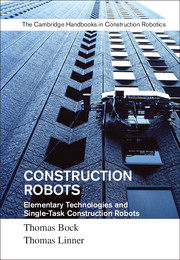Refine search
Actions for selected content:
4521 results for robotics
Title match
13 - Robotics
-
-
- Book:
- The Cambridge Handbook of Artificial Intelligence
- Published online:
- 05 July 2014
- Print publication:
- 12 June 2014, pp 269-295
-
- Chapter
- Export citation
Title match
27 - Robotics
- from Part V - Industry Case Studies
-
- Book:
- Industrial Policy for the United States
- Published online:
- 08 November 2024
- Print publication:
- 21 November 2024, pp 539-553
-
- Chapter
- Export citation
1 - The Robot
-
- Book:
- Biomimetic Robotics
- Published online:
- 20 February 2010
- Print publication:
- 26 January 2009, pp 1-24
-
- Chapter
- Export citation
5 - The Robot
-
- Book:
- The Map-Building and Exploration Strategies of a Simple Sonar-Equipped Mobile Robot
- Published online:
- 05 March 2012
- Print publication:
- 26 July 1996, pp 49-54
-
- Chapter
- Export citation
2 - Cleanroom robotics
-
- Book:
- Robotics for Electronics Manufacturing
- Published online:
- 06 July 2010
- Print publication:
- 06 May 2010, pp 12-29
-
- Chapter
- Export citation
Robot magic show: human–robot interaction
- Part of
-
- Journal:
- The Knowledge Engineering Review / Volume 35 / 2020
- Published online by Cambridge University Press:
- 07 April 2020, e15
-
- Article
- Export citation
1 - Industrial robotics
-
- Book:
- Robotics for Electronics Manufacturing
- Published online:
- 06 July 2010
- Print publication:
- 06 May 2010, pp 1-11
-
- Chapter
- Export citation
Appendix A - Fictional Robots
-
- Book:
- Computational Principles of Mobile Robotics
- Published online:
- 19 March 2024
- Print publication:
- 08 February 2024, pp 365-369
-
- Chapter
- Export citation
6 - Learning for Robots
- from Part two - Representation and Planning
-
- Book:
- Computational Principles of Mobile Robotics
- Published online:
- 19 March 2024
- Print publication:
- 08 February 2024, pp 161-184
-
- Chapter
- Export citation
18 - We and the robots
-
-
- Book:
- What Matters Most
- Published by:
- Agenda Publishing
- Published online:
- 23 January 2024
- Print publication:
- 18 May 2023, pp 163-170
-
- Chapter
- Export citation
Sophia Robot: An Emergent Ethnography
-
- Journal:
- TDR: The Drama Review / Volume 65 / Issue 3 / September 2021
- Published online by Cambridge University Press:
- 15 September 2021, pp. 42-77
- Print publication:
- September 2021
-
- Article
- Export citation
11 - Robots in Society
-
- Book:
- Human-Robot Interaction
- Published online:
- 20 February 2020
- Print publication:
- 07 May 2020, pp 185-200
-
- Chapter
- Export citation
Part II - Robots and Their Receivers
- from The Thesis
-
- Book:
- Robotica
- Published online:
- 11 May 2018
- Print publication:
- 31 May 2018, pp 32-47
-
- Chapter
- Export citation

Construction Robots
- Elementary Technologies and Single-Task Construction Robots
-
- Published online:
- 27 January 2017
- Print publication:
- 24 October 2016
21 - The Ubuntu Robot
- from Part III - Ethics, Culture, and Values Impacted by Human–Robot Interactions
-
-
- Book:
- The Cambridge Handbook of the Law, Policy, and Regulation for Human–Robot Interaction
- Published online:
- 07 December 2024
- Print publication:
- 21 November 2024, pp 408-420
-
- Chapter
- Export citation
8 - People and Robots
-
- Book:
- Extinction Equilibrium
- Published by:
- Bristol University Press
- Published online:
- 16 April 2025
- Print publication:
- 21 October 2024, pp 129-144
-
- Chapter
- Export citation
12 - Robots in Society
-
- Book:
- Human-Robot Interaction
- Published online:
- 13 June 2024
- Print publication:
- 27 June 2024, pp 229-249
-
- Chapter
- Export citation
11 - Robot Collectives
- from Part three - Advanced Topics and the Future of Mobile Robotics
-
- Book:
- Computational Principles of Mobile Robotics
- Published online:
- 19 March 2024
- Print publication:
- 08 February 2024, pp 301-315
-
- Chapter
- Export citation
